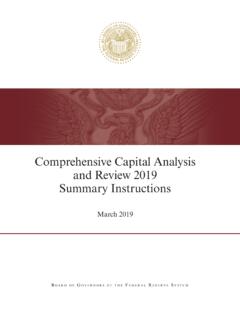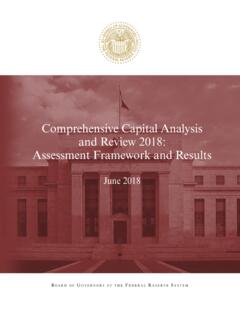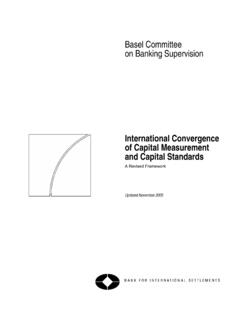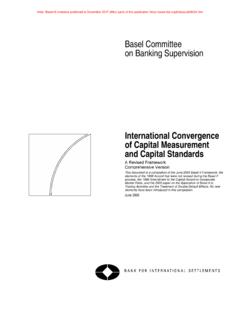Transcription of Exposure Draft for the Revision to the Standards of ...
1 360 Albert Street, Suite 1740, Ottawa ON K1R 7X7 Exposure Draft Revision to the Standards of Practice to Incorporate Changes to Section 2500 Dynamic Capital Adequacy Testing (Red-lined) Actuarial Standards Board January 2019 Document 219011 Ce document est disponible en fran ais 2019 Actuarial Standards Board 360 Albert Street, Suite 1740, Ottawa ON K1R 7X7 Memorandum To: All Fellows, Affiliates, Associates, and Correspondents of the Canadian Institute of Actuaries, and other interested parties From: Conrad Ferguson, Chair Actuarial Standards Board Marco Fillion, Chair Designated Group Date: January 21, 2019 Subject: Exposure Draft for the Revision to the Standards of Practice to Incorporate Changes to Section 2500 Dynamic Capital Adequacy Testing Comment Deadline: April 30, 2019 Introduction This Exposure Draft (ED) proposes changes to section 2500 Dynamic Capital Adequacy Testing of the Standards of Practice (SOP).
2 It was approved by the Actuarial Standards Board (ASB) on January 18, 2019. A notice of intent (NOI) to provide the background and general information on these proposed changes was distributed by the ASB on November 24, 2017, with a comment deadline of March 29, 2018. Background The objectives of the proposed revisions to section 2500 Dynamic Capital Adequacy Testing are to: Provide a more robust approach to satisfy the federal and provincial insurance acts requirement to report on the expected future financial condition of an insurance entity; and Allow for a better alignment with Own Risk and Solvency Assessment (ORSA) regulatory requirements as they relate to work needed to report on the expected future financial condition of an insurance entity. Insurers specific size, complexity, and other circumstances may have a significant influence on the appropriate level of harmonization between section 2500 and ORSA.
3 2 The proposed changes to section 2500 are not prescribing the level of harmonization. It is the insurer s decision. Proposed Changes Some of the changes are significant and introduce new concepts to financial condition testing. An educational note is planned to be issued later in 2019 by the Committee on Risk Management and Capital Requirement and before the changes are made effective to provide the actuary with the necessary guidance to apply the revised standard. The key changes are summarized below. Name of the Standard Dynamic Capital Adequacy Testing (DCAT) is renamed Financial Condition Testing (FCT). This is more reflective of the Insurance Companies Act (ICA) (similarly for provincial acts) which requires that the actuary report on the expected future financial condition of the company , and of proposed expanded definition of satisfactory financial condition and ORSA s core principle of assessing current and future solvency positions.
4 Definition of Satisfactory Financial Condition The threshold for the base scenario is changed to internal target rather than the regulatory supervisory level. It is the designated group s (DG s) view that meeting internal targets is more consistent with regulatory expectations regarding current regulatory capital reporting. In addition, the definition of satisfactory financial condition is expanded to test two thresholds: going concern and gone concern. Going concern scenarios test the minimum regulatory targets. Gone concern scenarios test the sufficiency of assets to meet the statement value of the liabilities, as required in the current Standards of practice (SOP). All three thresholds must be tested and passed to provide a satisfactory opinion. This is consistent with regulatory frameworks which concern themselves with not only the risk of insolvency (gone concern), but also with insurers ability to withstand severe scenarios under stressed condition while remaining viable (going concern).
5 The DG recognizes that the testing the concept of going concern is challenging and will also require practical guidance, which is expected to be included in the educational note. Opinion of the Actuary The opinion is modified to: Link to ORSA internal targets; Explicitly allow for a qualified opinion the ED gives guidance on when a qualified opinion would be appropriate; and Remove wording related to scenarios tested and their description in the report, significant assumption described in the report, and the identification of key risk exposures in the report. 3 Recent Financial Position and Forecast Period The ED no longer suggests a specific number of years for the review of the recent financial position and the forecast period. The most appropriate number of years is left for the actuary to decide, based on the facts and circumstances of the insurer and the analysis.
6 Risk Categories The detailed listings of risk categories are removed. The DG felt that those sections were not adding value to the SOP as they are already well documented in educational notes and other literature. Instead, the SOP will remind the actuary that risk categories should be assessed and relevant ones should be tested. General Harmonization with ORSA Throughout section 2500, wording is added to refer to ORSA or other processes where coordination could be beneficial. Feedback from Stakeholders In its NOI, the ASB solicited feedback on a number of questions. Major issues raised by stakeholders and proposed responses are summarized below. Feedback was received from CIA committees, regulators, and insurers. The DG appreciates the feedback received and has considered it in the development of the ED. 1. Conceptually, the ORSA should be sufficient to provide the AA the necessary information to report on the financial condition of the insurance entity.
7 How prescriptive should the SOP be in harmonizing the work of the AA with the ORSA process (scenarios, stress tests, internal targets setting, reporting, etc.)? Should it allow flexibility to have a fully separate process? Why? The feedback received was there is value and efficiency in harmonizing the timing, tools, models, and assumptions used in both processes, including the reports. However, the SOP should allow for flexibility of approach and the guidance should not be prescriptive as it relates to harmonization. Companies should have a choice to integrate their DCAT and ORSA processes or keep them separate, if appropriate. The DG agrees with the need for flexibility. The Draft SOP allows for the harmonization of ORSA and FCT processes or keeping them separate. However, the ED highlights the need for coordination of certain aspects between ORSA and FCT; for instance, use of ripple effects or commenting on the consistency of the results with ORSA.
8 There was some concern that since the actuaries may not be responsible for ORSA, the CIA should prescribe a few well-defined DCAT scenarios to allow for comparison across companies, and the Appointed Actuary (AA) should explain and justify their overall use of the ORSA process. One of the main purposes of FCT is to identify an insurer s key risks and the solvency risk associated with them. Those risks can vary significantly between insurers due to their 4 different sizes and complexity. Well-defined scenarios may even be irrelevant for some insurers. For that reason, the use of well-defined scenarios was rejected. 2. What changes to the current SOP section 2500, including the definition of satisfactory financial condition, can be made to make it more robust ( , inclusion of stress testing and integrated scenarios, etc.), effective ( , not a compliance exercise), and value-added to management and the Board ( , why analyse and report the same risks through different processes)?
9 The feedback received varies in degree but was consistent that the SOP should allow the AA to consider results of other scenario testing, such as ORSA, and harmonize (with appropriate review), and that the definition of satisfactory financial condition should be strengthened beyond the current approach, such as by using an internal target. The proposed changes to the SOP are aligned with these comments. As discussed above the ED highlights the need to coordinate FCT with other scenario testing done by the company, such as ORSA. This would promote communication and comparison of analysis between the FCT and ORSA. The satisfactory financial condition was strengthened to test the insurer s ability to operate on a going concern basis, and in addition to test gone concern scenarios, similar to today. Going concern scenarios test the insurer s ability to meet regulatory minimum targets.
10 3. Are internal targets the appropriate focal point in harmonizing DCAT and ORSA? If so, should the AA review, assess, or use the determination of the internal targets set by ORSA in his/her assessment of the satisfactory financial condition? The feedback received varied. Most agreed that the zero surplus target is inadequate. Some felt that internal targets should be determined by the AA and used in the AA s financial condition analysis. Internal targets are the logical focal point in harmonizing DCAT and ORSA and should be aligned with the risk appetite of the insurer. Others suggested that the most appropriate targets should be those based on regulatory accounting and capital requirements, such as one that satisfies minimum regulatory requirements. The feedback also suggested that if the AA uses the ORSA process and results in assessing the company s financial condition, then the AA should explain and justify the overall level of use of the ORSA process.











